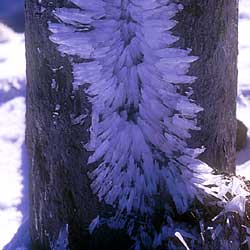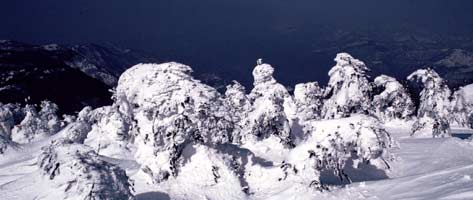 In central Italy, on the Apennine ridge between Tuscany and Romagna, there's
an enchanted forest…
In central Italy, on the Apennine ridge between Tuscany and Romagna, there's
an enchanted forest…
It could, of course, be the classic beginning of a fairy tale, but we're
not in the realms of fantasy and imagination but in the kingdom of His
Majesty Winter and his icy consort, the Cold Season.
The area we're talking about is that of the Parco Nazionale del Falterona,
of Campigna and the Casentino forests, a large, unbroken, green cloak
(white in winter) covering 10,601 hectares, a stretch of the Apennines
that runs from the Passo dei Mandrioli to Monte Falterona. "A full-blown,
wild botanical garden" (Pratesi-Tassi), these extensive beech woods,
mixed with silver fir and Norway spruce, have managed to remain intact
right through to the present day thanks to careful management of the area
over the last thousand years; this was begun by the monks of Camaldoli,
continued by the Grand Dukes of Tuscany, and is now the responsibility
of the government since the area became part of State lands.
In this particular climatic zone, which is influenced by its proximity
to the Adriatic and Tyrrhenian seas, there is abundant snow and also -
more so than in other areas - a phenomenon known in Italian as galaverna:
a myriad of ice needles that, pushed by the prevailing wind, form on branches,
tree trunks and pretty much everything else, forming a fantastic and highly-original
landscape not dissimilar to a strange seabed.
Related to snow and frost, galaverna (which in Tuscany is also called
bioccio or bruscello) is a natural wonder that only occurs in the intermediate
seasons of spring and autumn in the mountains of central Italy. It sometimes
results in considerable damage, with the sudden snapping of tree trunks
("… e senza alcun rattento li rami schianta, abbatte e porta
fori", Dante, Inferno IX, 69); more often, fortunately, it provides
a fabulous experience for those fortunate excursionists who brave the
cold and have the good fortune to witness it. But like all magic spells
(which is what it is), it doesn't last long, and just the merest hint
of warmth from a ray of sunlight is enough for it to vanish, as if by
magic, into simple, ordinary drops of water.
 To enjoy such experiences and admire magnificent landscapes, there's
no need to undertake goodness knows what expedition to the Arctic Circle;
all you have to do is come to these forests, put on a pair of snowshoes,
and start walking. The whole area can of course be crossed using either
downhill or cross-country skis but in my view, given the particular contours
of the land and above all the thick web of beech trees that almost completely
cover the area, it's much more practical to use snowshoes, the ancient
method of winter locomotion. Long considered obsolete, and hung up years
ago on rusty nails in mountain cabins and refuges, snowshoes are the product
(at least in Europe) of a mountain culture and a knowledge of how to adapt
in order to move around in the mountains even in very deep snow. Made
with wood and dried animal gut, they were developed in the distant past
by semi-nomadic peoples inhabiting Arctic areas, for example the Inuit,
the Athabaskan and the Algonquin Indians, who used them to go hunting.
In recent years they have been rediscovered by the outdoor pursuits industry,
which has designed and mass-produced modern versions, applying the latest
technology and using lighter and more modern materials like aluminium
alloys and plastic.
But why all this success after so many years of neglect? Well, let's consider
the pros and cons.
Snowshoes enable you to walk in woody or rough terrain, going places skis
can't go and making it possible to carry heavy loads. They distribute
bodyweight over a larger surface, thereby applying less pressure on the
blanket of snow so you don't sink in too much.
They are light, non-bulky to carry and easy to use. The forward-movement
technique depends somewhat on the type of terrain and the quality of the
snow, but involves easily-grasped movements to which one can adapt with
the same naturalness as walking, without having to learn any special ascent
or descent techniques, as you do with skis. Used together with sticks,
it's always possible to place them flat, thereby maintaining good equilibrium
and a good pace, both on the level and when climbing. Going downhill is
a real pleasure, because you can feel what it's like to be a deer, jumping
and sinking into the snow as you execute exciting rapid slides in the
snow combined with little jumps.
Until a few years ago, when the scarcioni or the ciaspole (dialect terms
for snowshoes) were still of the old-fashioned kind, there could be problems
on hard snow or when the slope was too steep. Now, thanks to a semi-moveable,
quick-fastening device similar to that used in downhill skiing, and to
crampons positioned on the front and sides, this form of equipment has
become much more technically-advanced and safe, even on icy patches.
In short, in a more natural way than with skis, snowshoes enable you to
penetrate the muffled and magical world of the white forest, to follow
the trail of animals, and to witness one of the most wonderful shows that
Mother Nature gives us each year… the arrival of the Cold Season
and her royal consort, icy Winter.
|